ANZAC and India's Legacy in WWI
The average Indian is almost ignorant about Gallipoli as a campaign in World War I. India's enormous contribution remains relatively unrecognised in Australia and unknown to India.

Anzac Day, the day on which the Anzac landing at Gallipoli in 1915 is annually commemorated on 25 April and is one of Australia’s most important national occasions.
Anzac stands for Australian and New Zealand Army Corps. The soldiers in those forces quickly became known as Anzacs, and the pride they took in that name endures to this day.

The Gallipoli campaign was intended to force Germany’s ally, Turkey, out of the war. It began as a naval campaign, with British battleships sent to attack Constantinople (now Istanbul). This failed when the warships were unable to force a way through the straits known as the Dardanelles.
A third of the battleships were sunk or disabled on a single day, 18 March 1915

A fresh plan was devised: the army under Sir Ian Hamilton would occupy the Gallipoli peninsula. This would eliminate the Turkish land and shore defences and open up the Dardanelles for the passage of the navy. It would involve British troops first capturing the tip of the peninsula on 25 April, then advancing northwards. Meanwhile the Anzacs would land on the western coast north of Gaba Tepe, at a narrow point on the peninsula. The British and Anzac forces only succeeded in getting a toe-hold on the peninsula. Over the next eight months little progress was made, and the Anzacs were evacuated in December. By January 1916 the last British troops were withdrawn, and the venture abandoned.
While reading up on ANZAC day, I wondered if India and Indians had played any role in this battle or the WWI for that matter. What I learnt next was mind-boggling! Feelings of great sorrow, helplessness, despair experience by the people at the time and shame that I didn’t know any of this information.
Historians believe almost 1,400 Indians died at Gallipoli and up to 3,500 were wounded.

“The average Indian is almost ignorant about Gallipoli as a campaign in World War I,” retired Indian Air Force wing commander Rana Chhina said.
The Indian contribution to the First World War was in the form of seven Expeditionary Forces (A to G), fighting in the Western front, East Africa Campaign, British East Africa, Mesopotamia, Sinai and Palestine, First Suez Offensive and the Gallipoli Campaign. The Mesopotamia Campaign was almost entirely an Indian one.
It was Expeditionary Force G that fought in the Gallipoli Campaign. It comprised the 29th Indian Brigade, which had under its command four Infantry Battalions, namely: 14th (King Georges Own) Ferozepur Sikhs, 1/5th Gurkha Rifles (Frontier Force), and the 1/6th and 2/10th Gurkha Rifles. An artillery component: 7th Mountain Artillery Brigade with 21st (Kohat) and the 26th (Jacob’s) Mountain Batteries, equipped with breech-loading 10-pounder guns.

Excerpt from Robert Schuman Centre for Europe on World War I casualties* Link to report in references below.
In fact, as an average Indian, I was totally unaware of the sheer magnitude of Indias sacrifice and contribution to the War and Britains coffers.
74,187 military death in WWI alone!
The more I read, the more heart-wrenching it became.
In 1930, the American writer, historian, and philosopher, Will Durant was on a visit to India as part of collecting data for The Story of Civilization. He was so taken aback by the devastating poverty and starvation he saw as result of British imperial policy in India that he took time off from his stated goal and instead concentrated on his polemic fiercely advocating Indian independence.

In his book, The case for India, he writes “ During the nineteenth century India paid $450,000,000 for wars fought for England outside of India with Indian troops. She contributed $500,000,000 to the War chest of the Allies, $700,000,000 in subscriptions to War loans, 800,000 soldiers and 400,000 labourers to defend the British Empire.”
Further on he notes that “ None of the Hindu soldiers were granted a commission, not matter how brave he might have proved himself.”

Oral histories were taken from Indian veterans in the 1970s by a team led by DeWitt Ellinwood, an American historian and anthropologist. Transcripts of the recordings have been offered to the British Library by George Morton-Jack, a British historian who traced the material to Ellinwood’s house in upstate New York where it had been stored for decades.
Sujan Singh, who was 80 when he was interviewed, said: “We were slaves.” Nand Singh spoke of a “curtain of fear” separating the Indian and white soldiers. They were subject to floggings and other inhumane physical punishment, paid less than their white counterparts, segregated in camps and on trains and ships, denied home leave, and barred from positions of command.
“The British treatment of them was painful in many ways, but at the time they routinely did not speak the truth of their hearts to British power. Their feelings come out in the transcripts,” said Morton-Jack.
The Victoria Cross, the highest and most prestigious award of the British honours system awarded for gallantry “in the presence of the enemy” to members of the British Armed Forces, was awarded to 11 Indian soldiers in WWI

In April 1915, Dast won the Victoria Cross for his actions in Ypres under chemical attack. The Germans had released poisonous chlorine gas from trench cylinders in yellow-green clouds that rolled on the breeze over the attacking Indian troops.
“I inhaled the gas, say, for eight or ten seconds,” Mir Dast estimated, “It brought water from my eyes and nose.” Yet he fought on, rescuing wounded comrades and carrying them back to the British trenches into the night.


This ANZAC day, I salute the spirit, courage and bravery the of Indian soldiers and India’s INCREDIBLE sacrifice which has remained unacknowledged for far too long. Let’s acknowledge it before it is erased from the pages of history — Lest we forget the forgotten!
If this story touched a chord, do leave a comment, share or talk about it.
Twitter: https://twitter.com/MitraDesai
Youtube: http://bit.ly/TejomayaBharat?sub_confirmation=1
References:
1: The Anzac Day Tradition | The Australian War Memorial
www.awm.gov.au
2: India's 'forgotten soldiers' who fought at Gallipoli
Updated April 25, 2015 08:34:34 Up to 15,000 Indians fought with allied troops at Gallipoli, but their contribution
www.abc.net.au
3:Anzac and India: A shared but forgotten camaraderie
www.freeperception.com
4: Indians in the trenches: voices of forgotten army are finally to be heard
www.theguardian.com
5: Six extraordinary Indian stories from World War One www.bbc.com
6: Mir Dast - Wikipedia en.wikipedia.org
7: World War I casualties
http://www.centre-robert-schuman.org/userfiles/files/REPERES%20%E2%80%93%20module%201-1-1%20-%20explanatory%20notes%20%E2%80%93%20World%20War%20I%20casualties%20%E2%80%93%20EN.pdf




Comments ()